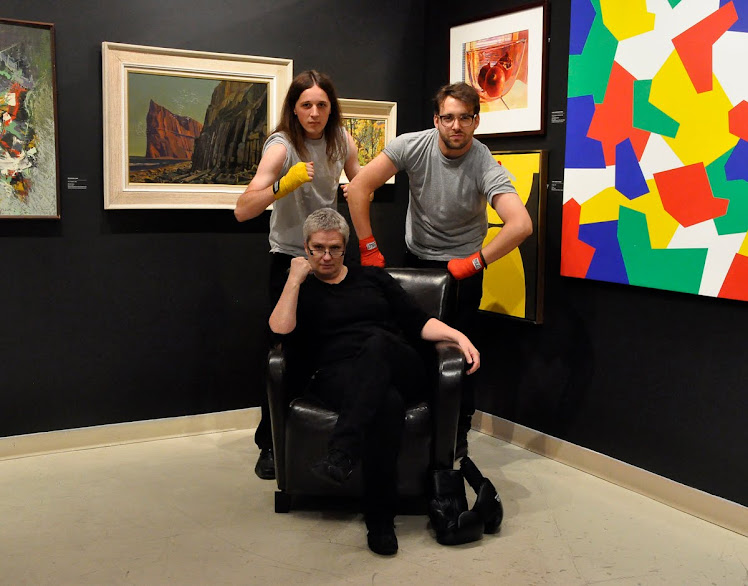 In the permanent collection room I find my self a pretty diverse rack. It holds mostly abstract paintings but also a few landscapes and a still life or two. I am immediately drawn to Lawrence (Larry) King's Fiesta, 1967. This abstract circle mighty just be what I need to save my selection on day 2, Tony Tascona's Quarter Cycle.
In the permanent collection room I find my self a pretty diverse rack. It holds mostly abstract paintings but also a few landscapes and a still life or two. I am immediately drawn to Lawrence (Larry) King's Fiesta, 1967. This abstract circle mighty just be what I need to save my selection on day 2, Tony Tascona's Quarter Cycle. Out in the gallery it fits! There's room for just one piece on this side of the room, and Fiesta, works between Quarter Cycle and Urquhart's Hero, mirroring some of the colours in the Napoleonic Uniform while stretching to scale of the circular Tascona. Fiesta, is a mixed media work, using acrylic, rice paper and ink on masonite. It looks, like it could almost be a collage constructed out of torn up remnants of its two neighboring works.
Out in the gallery it fits! There's room for just one piece on this side of the room, and Fiesta, works between Quarter Cycle and Urquhart's Hero, mirroring some of the colours in the Napoleonic Uniform while stretching to scale of the circular Tascona. Fiesta, is a mixed media work, using acrylic, rice paper and ink on masonite. It looks, like it could almost be a collage constructed out of torn up remnants of its two neighboring works.In our discussion and collective dialogue about placement, I begin question if whether or not i have made the best choice, both Darryn and I return to the collection storage to see what else we might consider. I bring out an abstract painting by Paul Sloggett, tittled March Dun, from 1994. It serves Tascona as well as its colours and investigation of line are very similar. Where
 March Dun differs is the use of paint where in contrast to Quarter Cycle, its lines are rough and the paint is built up. It doesn't out weigh Fiesta, confirming my first gut instinct, but it does do some thing, So we try it on the other side of the entrance creating a gateway between it and the Tascona.
March Dun differs is the use of paint where in contrast to Quarter Cycle, its lines are rough and the paint is built up. It doesn't out weigh Fiesta, confirming my first gut instinct, but it does do some thing, So we try it on the other side of the entrance creating a gateway between it and the Tascona.This works really well, but means that my choice number one, Hugh Mackenzie's Seated Figure, is getting bumped out for the greater good.
In our files I find its Application for Certification of Cultural Property for Income Tax Purposes, containing an Explanation of Outstanding Significance and National Importance, which describes this new work (at the time) in comparison to his early practice.
"Less emphasis is placed on texture and flat area's of geometric form. Instead, line plays a greater role while some of the rough shapes are loosely filled in with colour. There is some residue of the geometric shapes of past work but it is far less structured. A painted frame, withing the actual frame surrounds the work which adds to the floating quality of the image. Although it was painted in the last two years, it is a significant work and it will add considerable strength to the abstract collection of Gallery Lambton."
This statement perfectly illustrates March Dun's relationship with Tascona's Quarter Cycle. I'm glad to finish day 6 with a sense that we were able to round off the show, to present to our First Friday patrons, online followers and a couple weeks or so of gallery goers.

Paul Sloggett, born in Campbellford Ontario in 1950, graduated Ontario College of Art, in 1973. Awarded Royal Canadian Art Association recognition in 2001. Professionally Sloggett has taught drawing and painting as an assistant professor at York University and, currently, full time at OCAD. In addition to his teaching Sloggett has served as MFA Advisor at York and Assistant Dean of the Faculty of Art at OCAD.

No comments:
Post a Comment